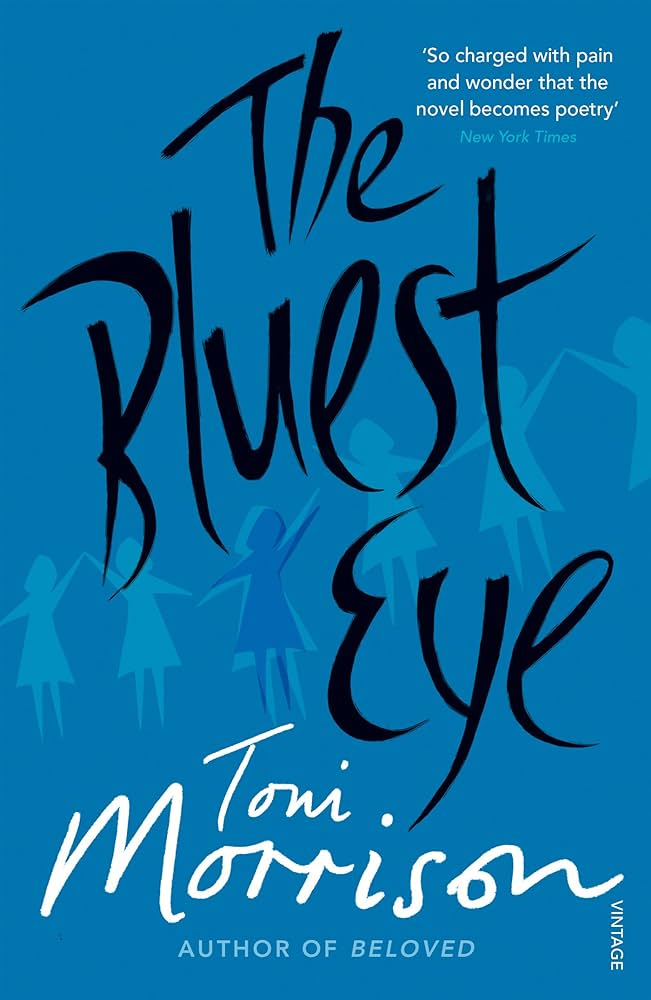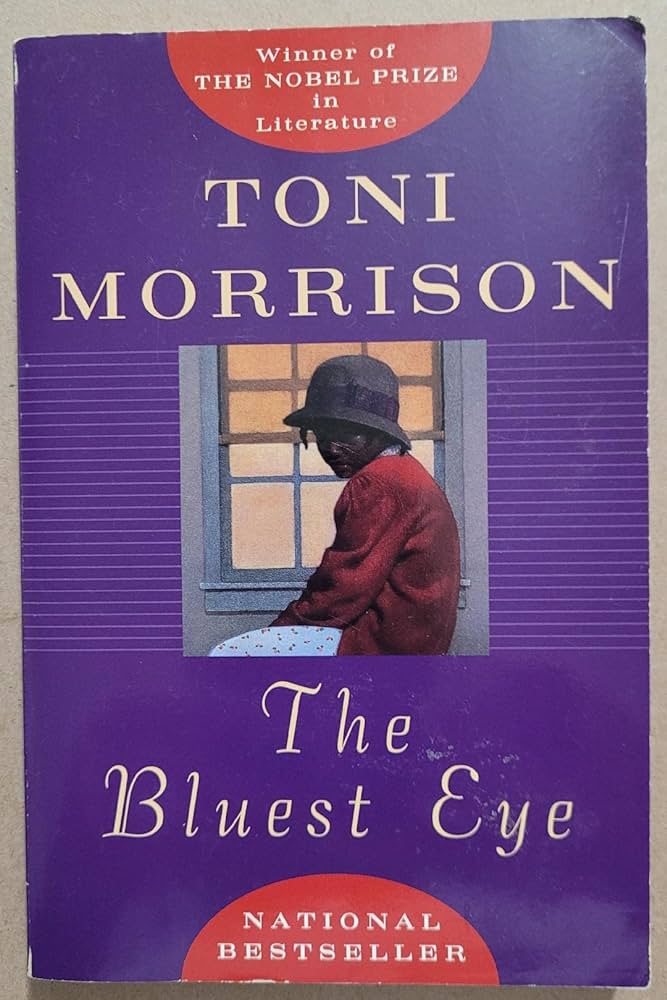Trigger Warning: Rape, racism
The book The Bluest Eye by Toni Morrison is a thought-provoking and gut-wrenching novel that deals with love, loss, heartbreak and the outrageous standards of beauty that were enforced in the 1940s. Beauty in its entirety has always had its idealistic standards of what is acceptable. In conventional beauty standards, fair skin is applauded. The Bluest Eye set in the 1940’s is a classic and awe-inspiring story of a girl who wishes to have blue eyes. It is a saga of love and heartbreak and it calls out the notions of racism, toxic beauty standards and patriarchy. This review trues to analyse the symbolism of the various nuances present in the plot and their intricate interplay with prejudice and discrimination through the journey of the main character.
About the author Toni Morrison
American author Toni Morrison, whose real name is Chloe Anthony Wofford, is renowned for her exploration of the black experience—particularly that of black women—in the black community. On February 18, 1931, she was born in Lorain, Ohio in the United States,. Morrison was raised in a family that valued and loved black culture in the American Midwest. Folktales, music, and storytelling had a profoundly influential influence on her upbringing.
Morrison’s debut book, The Bluest Eye (1970), is a novel about a black adolescent girl who is fixated by white beauty standards and yearns to have blue eyes. Her second book, Sula, was released in 1973 and explores a variety of topics, including the complexities of friendship and social pressures to fit in. The male narrator of Song of Solomon (1977) tells his story while trying to figure out who he is. Morrison gained widespread recognition after the book’s release. Set on a Caribbean island, Tar Baby (1981) examines issues of sex, race, and class.
Morrison’s debut book, The Bluest Eye (1970), is a novel about a black adolescent girl who is fixated by white beauty standards and yearns to have blue eyes.
The true story of a fleeing slave who kills her young daughter to protect her from a life of slavery at the point of recapture is the basis for the critically acclaimed 1987 Pulitzer Prize–winning novel Beloved. Jazz (1992) is a violent and passionate story that takes place in 1920s Harlem, New York City. The books that followed are Paradise (1998), which paints a vivid picture of a black utopian village in Oklahoma, and Love (2003), a complex family tale that illuminates the various dimensions of love and its seeming antithesis. (2008) A Mercy examines slavery in America during the 17th century.
The Bluest Eye: plot and narrative
The African American experience is Morrison’s main literary focus.
Her characters battle to define their cultural identities in an unjust society. Her stories have a lot of depth and texture because of the fantasy elements, poetic style, and creative writing approach she employed. The Bluest Eye is based on the protagonist’s obsession with having blue eyes. The book centres around a black girl and her yearning to look beautiful and fit the ‘deemed White standards’ of beauty. The Bluest Eye narrates the tale of the young African American girl, Pecola and her family, who are impacted by mainstream American culture on many fronts.
Pecola has gone through difficult times because her mother, Mrs. Breedlove, is a caretaker. She has little regard for her own daughter and instead chooses to work and look after the child in a white family. Her father, Cholly Breedlove, is a violent alcoholic who rapes Pecola until she becomes pregnant. Her parents frequently argue, and during these fights, there is physical violence. Samuel, Pecola’s brother, runs away from the violence as a result. The reader discovers that Pecola’s parents both experienced catastrophic events in their lives, which contributed to their dysfunction as adults. Cholly Breedlove, her father, was cast away by his father after he had looked at him as a newborn.
Mrs. Breedlove, Pecola’s mother, has a disabled foot and has always felt unattractive and alone. She used to get lost in films as a young woman. She believed that she was ugly because of the stunning white actors on screen.
The Bluest Eye narrates the tale of the young African-American girl, Pecola and her family, who are impacted by mainstream American culture on many fronts.
In a desperate move, Pecola goes to see Soaphead Church, who says he can perform miracles and begs for blue eyes. The Bluest Eye heartbreakingly makes readers question the deemed norms of society and leaves a resilient mark through its storytelling.
The criticism of white beauty standards in The Bluest Eye
Racism has made its way from history into modern-day society. The privilege that white people and fair-skinned individuals get is not hidden from anyone. White Privilege is a social construct formed as a product of capitalism and colonialism. Tony Morrison, an active participant in shunning the racist and patriarchal norms, succeeds in laying a strong framework of criticism through The Bluest Eye.
The main strength of The Bluest Eye is that Toni Morrison, the author, aims at the central issue of the work—white beauty. Since beauty is a relative concept, different people would have different opinions about what beauty is. While acknowledging that other races occasionally alter their standards when influenced by White culture, Knight Dunlap, via Alfred Strom, asserts that ‘Beauty varies distinctly from race to race, so that such concepts can not be accurately compared across racial lines’
However, when black people are systemically oppressed by white people, their standards can occasionally shift. In actuality, black women experience distress due to white beauty ideals. Women who fall short of society’s accepted standards of beauty experience feelings of inadequacy, isolation, and low self-worth. This is what occurred to Pecola, the protagonist of the book, who believes she is the most ugly person living as she does not meet the ideal of white beauty.
Women who fall short of society’s accepted standards of beauty experience feelings of inadequacy, isolation, and low self-worth.
Take these lines from The Bluest Eye– ‘It had occurred to Pecola some time ago that if her eyes, those eyes that held the pictures, and knew the sights—if those eyes of hers were different, that is to say, beautiful, she would be different. Her teeth were good, and at least her nose was not big and flat like some of those 6 who were thought so cute. If she looked different, beautiful, maybe Cholly would be different, and Mrs. Breedlove too. Maybe they’d say, “Why, look at pretty-eyed Pecola. We mustn’t do bad things in front of those pretty eyes.”’
It can be visibly concluded how much Pecola yearns to be white-skinned. Pecola believes that society, including her own family, has rejected her because of her ugly appearance. She knows she will never be considered attractive if she doesn’t have white skin and blue eyes, and as a result, she will never be able to appreciate the beauty in her own life. Additionally, she will receive better treatment from others if she satisfies the white beauty standard.
The patriarchal norms of sexually objectifying women
The Bluest Eye epicts the presence of the male gaze and the appeal of a woman as a perfect attention-seeking figure serving the eyes of the men. Take for example, the following lines from the book:
‘China chuckled. Whenever something was missing, Marie attributed its disappearance to “something in the house that loved it.” “There is somethin’ in this house that loves brassieres,” she would say with alarm. . . .“How come you got so many boyfriends, Miss Marie?” “Boyfriends? Boyfriends? Chittlin’, I ain’t seen a boy since nineteen and twenty-seven.” . . .Pecola fingered the fringe of a scarf that lay on the back of a sofa. “I never seen nobody with as many boyfriends as you got, Miss Marie. How come they all love you?” Marie opened a bottle of root beer. “What else they gone do? They know I’m rich and good-lookin’. They want to put their toes in my curly hair, and get at my money.”’
The above scene shows how only a woman who is good-looking and has the perfect sense of status and beauty appeals to be worthy of love and attention from men. Pecola in her innocence hears the banter between these women belittling the beauty she holds and questioning the roots she comes from. The Bluest Eye in many fragments shows us the toxic norms of appearance and behaviour in society and how detrimental it can be to young minds. The Bluest Eye demonstrates how, in a racist setting, everyone is conditioned to aspire to be white. The idea that having blue eyes, blonde hair, and white skin equates to ultimate beauty is accepted by society without question.
All the non-blue-eyed, brown- or black-skinned children who never got to see their beauty mirrored in the eyes of people around them suffer from this insecurity. The author wishes to make it clear that beauty is something that may be achieved rather than just something to look at through what occurred to Pecola. The book lays a strong argument on how society should reform its way of what is acceptable and what is not in terms of beauty and discrimination based on race.
Contrasts and contradictions in The Bluest Eye
Another beautiful part of the book lies in the contrasting characters that the book holds. The Bluest Eye tells the story of Pecola who hates her black origin and on the other hand, presents the character of Claudia who is confident in how she looks and holds pride in her ethnicity.
In Claudia’s words from the book – ‘I hated Shirley. Not because she was cute, but because she danced with Bojangles, who was my friend, my uncle, my daddy, and who ought to have been soft-shoeing it and chuckling with me. Instead, he was enjoying, sharing, giving a lovely dance thing with one of those little white girls whose socks never slid down under their heels.’
The above lines tell us how much Claudia despised the white actress Shirley because of her acceptance in society as a privileged white woman. The beauty of contrast is well reflected in the book as the author encompasses multiple perspectives to strengthen her argument in the creation.
Dysfunctional family and abuse in The Bluest Eye
The intricacies of the plot are interwoven with the presence of dysfunctionality in Pecola’s family and the presence of sexual abuse. Take these lines from the book:
‘Quiet as it’s kept, there were no marigolds in the fall of 1941. We thought, at the time, that it was because Pecola was having her father’s baby that the marigolds did not grow. A little examination and much less melancholy would have proved to us that our seeds were not the only ones that didn’t sprout; nobody’s did…It had never occurred to either of us that the earth itself might have been unyielding. We had dropped our seeds in our own little plot of black dirt just as Pecola’s father had dropped his seeds into his own plot of black dirt. Our innocence and faith were no more productive than his lust or despair.‘
The themes of sexual abuse and violence shown in the book leave a long-lasting impact on the characters, leaving the readers heartbroken and contemplative of the reality of society.
The Bluest Eye succeeds in its attempts to weaken the patriarchal norms and raise a voice against racism, discrimination and abuse.
The perception of beauty is subjective and differs in its variations from each person’s perspective. What is not acceptable is the propagation of the idealised standard of beauty as white and fair-skinned. The Bluest Eye succeeds in its attempts to weaken the patriarchal norms and raise a voice against racism, discrimination and abuse. The story is heartbreaking and makes us question the conditioning we have been fueled with. Toni Morrison lays a benchmark in her work that challenges racism and the colonisation of beauty ideals.











